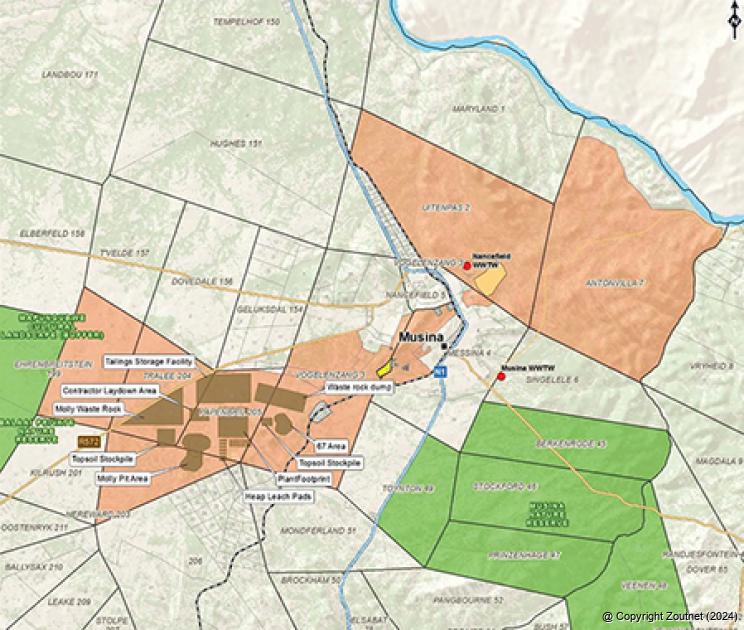

ADVERTISEMENT:

A map included in the environmental impact assessment report, detailing the proposed mining area of Smarty Investments that was tabled during the public participation meeting in January 2018.
Department grants IEA to Smarty (SA) for Musina copper mining project
The exploitation of the Soutpansberg’s rich mineral resources seems to have gained new momentum as the country slowly wakes up from its lockdown slumber. Last week, the Zoutpansberger reported on the first round of public-participation meetings regarding the proposed Musina-Makhado SEZ. At the same time, notice was received that the Department of Mineral Resources and Energy (DMRE) had granted an Integrated Environmental Authorisation (IEA) for a Musina copper-mining project.
The DMRE granted the IEA in terms of the National Environmental Management Act (NEMA) to Smarty (SA) Minerals Investment (Pty) Ltd for activities related to copper mining on the farms Uitenpas 2MT, Antonvilla 7MT, Messina 4MT, Vogelenzang 3 MT, Papenbril 205 MS, Hereward 203 MS, Tralee 204 MS and Plaatje 200 MS within the Musina municipal area in Limpopo Province.
Smarty first showed interest in Musina’s copper deposits in 2016, and on 23 January 2018, held its first public-participation meeting with interested and affected parties in Musina. The meeting was marred by controversy as attendees argued that representatives from Smarty were nowhere near prepared to answer community members’ questions, the main question being where the water for the mine will come from. The meeting was widely labelled as a total mess from beginning to end. Smarty themselves later admitted in their comment report drafted after the meeting that some reports had in fact been received only weeks before the meeting, meaning that they did not have sufficient time to study the results. The DMRE, as part of its explanation to grant Smarty its IEA, however, deemed the 23 January 2018 meeting sufficient as part of the public-participation process.
The granting of the IEA allows Smarty to undertake several regulated activities. These activities, among others, include the building of pipelines for water and waste water transport; development of facilities or infrastructure for the transmission and distribution of electricity; the development of dams or weirs, where the dam or weir, including infrastructure and water surface area, exceeds 100 square metres (Smarty applied for 100 hectares); the clearance of an area of 20 hectares or more of indigenous vegetation (in this case, Smarty applied for 879 hectares); and the establishment or reclamation of a residue stockpile or residue deposit resulting from activities that require a mining right, exploration right or production right.
The granting of the IEA is subject to several specific conditions. These conditions include that all development-footprint areas and areas affected by the proposed development must remain as small as possible and must not encroach onto the surrounding sensitive areas and the associated buffer zones. Smarty must also obtain an Integrated Water Use License (IWUL) from the Department of Water and Sanitation (DWS) prior to the commencement of activities. Wetland and riverine areas are also to be considered as no-go zones unless authorisation is obtained. Smarty must ensure that construction activities are outside the demarcated wetland area, and no activity should be allowed to encroach onto a wetland system. Furthermore, the pits must be backfilled with coarse waste rock as soon as this rock has been worked out. Barriers such as fencing or berms will be required to ensure that no humans or animals fall into the pits. Trenches for the laying of pipelines could be hazardous and must be backfilled as soon as possible. Lastly, Smarty must commit to the rehabilitation of all areas affected by their operations.
The DMRE has stated that anyone who wishes to appeal the decision, or any aspect of the decision, must submit the appeal in terms of Chapter 2 of the National Appeal Regulations of 2014 as amended. Such appeal must be lodged by Wednesday, 30 September 2020. The appeal must be submitted to Directorate Appeal and Legal Review at e-mail [email protected] or by post to Private Bag x 447, Pretoria, 0001. It can also be delivered by hand to Environmental House, corner Steve Biko and Soutpansberg Street, Arcadia, Pretoria, 0083.
A copy of the appeal must be submitted in writing to the DMRE for the attention of the Regional Manager: Limpopo Province at e-mail [email protected] or by fax to (015) 297 7230. It can also be posted to Private Bag X 9467, Polokwane, 0700 or delivered by hand at the DMR Building, 101 Dorp Street, Polokwane, 0699.
In terms of the EIA regulations, a copy of the appeal must also be provided to the applicant, any registered interested and affected party and any organ of State with an interest in the matter.
An electronic copy of the IEA can be downloaded from the website of Golder’s (the public-participation consultants) at https://www.golder.com/global-locations/africa/south-africa-public-documents/. A copy can also be obtained by contacting Brian Magongoa or Mabel Qinisile at the Golder Public Participation Office at Golder Associates Africa (Pty) Ltd, P O Box 6001, Halfway House, 1685, Tel: (011) 254 4800, Fax: (086) 582 1561 or e-mail [email protected].
News - Date: 25 September 2020

Recent Articles
-

Department shuts down Ziggy School
19 April 2024 By Thembi Siaga -

MMSEZ now also looking at nuclear power
19 April 2024 By Andries van Zyl -

Prophet Muritho's nightmare continues
19 April 2024 By Elmon Tshikhudo -

'When will the masterminds be arrested?'
19 April 2024 By Elmon Tshikhudo
Search for a story:

ADVERTISEMENT


Andries van Zyl
Andries joined the Zoutpansberger and Limpopo Mirror in April 1993 as a darkroom assistant. Within a couple of months he moved over to the production side of the newspaper and eventually doubled as a reporter. In 1995 he left the newspaper group and travelled overseas for a couple of months. In 1996, Andries rejoined the Zoutpansberger as a reporter. In August 2002, he was appointed as News Editor of the Zoutpansberger, a position he holds until today.
Email: [email protected]

ADVERTISEMENT:

